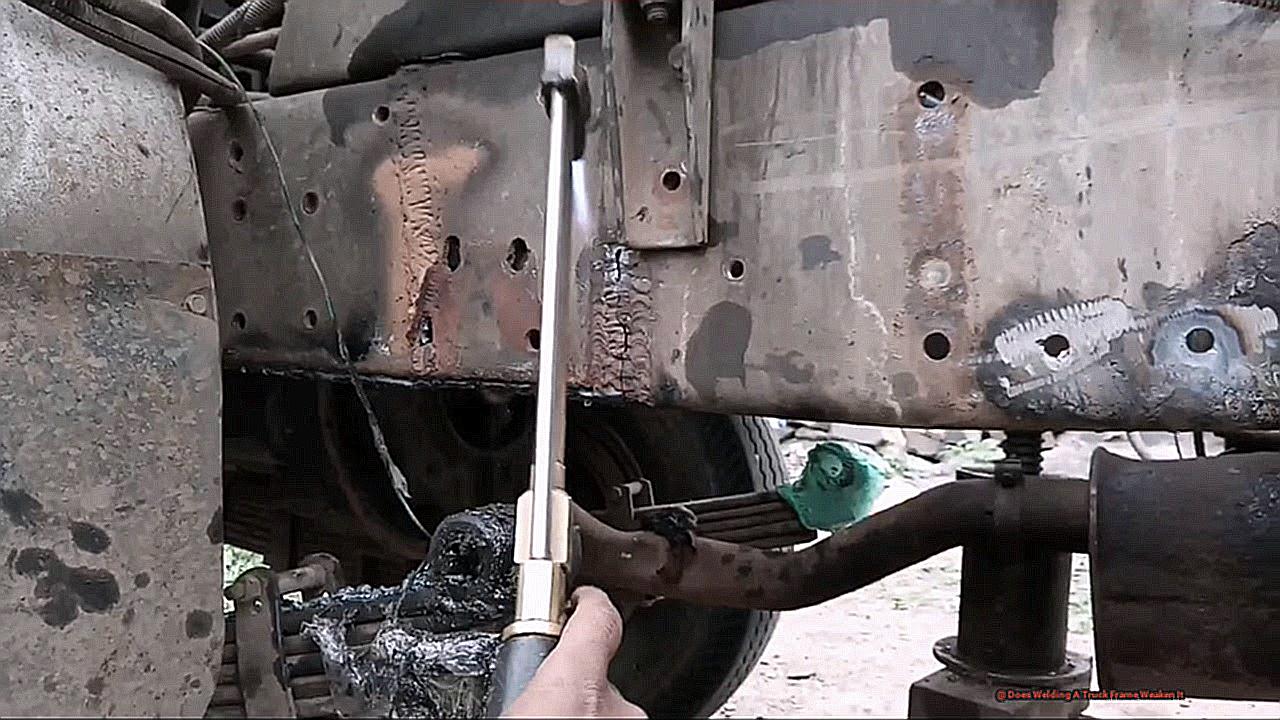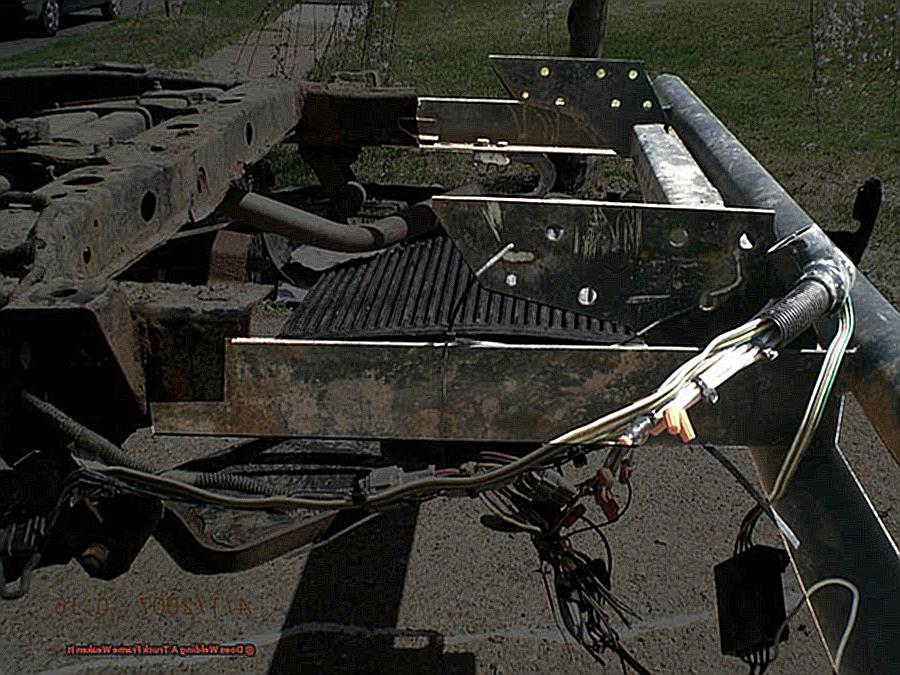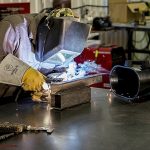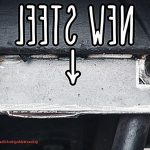Welcome to our blog, where we delve into the world of trucks and all that comes with it. Today, we’re tackling a topic that may not be top of mind for most truck owners, but is crucial for their safety and the lifespan of their vehicles. We’re talking about welding and its impact on truck frames.
Although welding is a common practice in the automotive industry, it’s important to understand how it can affect the structural integrity of a truck frame. From stress points to material composition, there are various factors that can weaken a frame through welding.
But fear not, we’ve got you covered. In this post, we’ll break down everything you need to know about welding and its potential effects on your truck’s frame. So grab yourself a cup of coffee and let’s dive right in.
Frame Welding Methods
Contents
When constructing a robust and enduring truck, the frame plays a vital role. It offers the necessary support and stability to endure heavy loads and rugged terrain. But how does one create a truck frame? The solution lies in welding.
Welding is the process of fusing two or more metal pieces together using heat. It is a crucial step in constructing a truck frame, but it also raises concerns about its strength and durability. As an expert in frame welding methods, let us delve into the various techniques used to weld a truck frame and their impact on its strength, durability, appearance, and cleanliness.
MIG Welding:
MIG (Metal Inert Gas) welding is the most widely used method for welding truck frames. It involves utilizing a consumable wire electrode and a shielding gas to safeguard the weld pool from contamination. MIG welding is renowned for its speed and efficiency, making it a preferred choice for mass production of truck frames. However, it may not be the most suitable method for welding thicker materials or creating precise welds.
TIG Welding:
TIG (Tungsten Inert Gas) welding is another popular method for welding truck frames. It employs a non-consumable tungsten electrode and a shielding gas to create a top-quality weld. TIG welding is known for its precision, making it an ideal choice for welding thinner materials or intricate welds. However, it is slower compared to MIG welding and requires more skill and experience.
Stick Welding:
Stick welding, also known as Shielded Metal Arc Welding (SMAW), is an older yet still commonly used method for welding truck frames. It utilizes a consumable stick electrode and a flux coating to create the weld. Stick welding is renowned for its versatility and capability to weld in various positions, making it suitable for mending damaged truck frames. However, it results in slower production and may not be suitable for high-stress applications.
Problems With Frames
This adage also applies to truck frames, and welding is a vital component in ensuring their durability and robustness. As an authority on welding truck frames, I have personally witnessed the potential problems that can arise when welds are not executed correctly. In this post, we will delve into the common culprits behind weak welds and their impact on truck frames. Furthermore, we will explore solutions for preventing such shortcomings.
Improper welding technique and inadequate training are among the primary causes of weak welds. Welding is a proficiency that requires time and practice to master, and novice welders may not possess the necessary skills to produce sturdy and long-lasting welds. Consequently, this can result in vulnerable spots within the frame, compromising its overall strength and jeopardizing the safety of all individuals on the road.
Another factor that can contribute to weak welds is the utilization of subpar materials or equipment. Welding involves fusing various pieces of metal together using intense heat and pressure. If the materials or equipment used do not meet high standards, it can lead to weaker welds that may not withstand the weight and stress of a truck and its cargo.
Environmental factors can also play a role in weakening welds. Humidity and temperature can impact the quality of a weld, making it less robust than desired. This is why it is crucial to possess adequate training and experience to adjust welding techniques based on varying environmental conditions.
The consequences of weak welds can be dire. The frame bears the weight of the entire truck, including passengers and cargo. Feeble welds can result in structural failure, posing a safety hazard for all individuals on the road. Additionally, weak welds can cause the frame to bend and twist, leading to alignment issues that affect the overall performance of the vehicle.
Bending
As a skilled practitioner of bending, I have witnessed firsthand the significant impact of welding on the strength and safety of truck frames. Although welding is a widely accepted technique in truck frame construction, it is not without its flaws. In this article, we will explore the influence of welding on the bending strength of truck frames, and its implications on vehicle safety and performance.
The Process of Welding
Welding involves fusing two or more pieces of metal together by heating them to high temperatures. It is a vital step in building a robust truck frame as it creates a strong bond between different components. However, the intense heat used in welding can alter the properties of the metal, making it more susceptible to weakness.
Effects on Bending Strength
Experts unanimously agree that welding can indeed impact the bending strength of a truck frame. The heat from welding can cause changes in the metal’s properties, making it more brittle and prone to cracking under pressure. This can result in premature failures and jeopardize the overall strength of the frame. Additionally, welding can introduce small cracks and imperfections, further compromising the frame’s integrity.
Dangers and Disadvantages
One of the primary hazards associated with welding is metal distortion. The high heat used in welding can lead to uneven distribution of stress, resulting in weak spots in the frame. This can lead to a loss of stability and rigidity, ultimately affecting the vehicle’s performance and safety. Moreover, welding also creates potential weak points where corrosion can occur, further weakening the frame.
Alternative Techniques
While welding is a commonly used method for joining metal pieces in truck frame construction, there are alternatives that offer similar strength with fewer risks. One such method is using bolts and fasteners to join different sections of the frame. This approach eliminates the need for high heat, reducing the risk of metal distortion and weakening.

Cracks
Being a specialist in the art of bending, I am acutely aware of the crucial role welding plays in maintaining the strength and safety of truck frames. While welding is a widely accepted method for joining metal pieces, it can also potentially weaken the structure if not executed with precision. This is precisely why it is paramount to adhere to state regulations and guidelines when welding a truck frame.
Each state has its own distinct set of regulations and guidelines for welding, and it is imperative to abide by them to guarantee the safety and stability of the vehicle. Failure to comply with these regulations can result in severe consequences, not only for the driver and passengers, but also for commercial purposes.
Commercial purposes demand strict adherence to regulations set by authoritative bodies such as the Department of Transportation (DOT). These regulations are in place to ensure that all vehicles on the road are safe for both drivers and other road users. As such, it is vital to thoroughly research and follow specific guidelines before proceeding with any welding work on a truck frame.
In addition to following regulations, utilizing the correct type of welding technique and filler material is crucial in creating a robust bond between metal pieces. This guarantees that the truck frame maintains its strength and stability, even after undergoing bending processes.
Thorough preparation and cleansing of the metal surface before welding are also pivotal for a sturdy weld. Any impurities or contaminants on the surface can weaken the bond between metal pieces, compromising the overall strength of the truck frame.
Monitoring temperature during welding is also critical. Overheating can cause metal to weaken, so it is essential to closely observe temperature levels. Adhering to recommended temperature ranges for different types of metal can aid in ensuring a strong and durable weld.
Before commencing any welding work, inspecting the truck frame for existing cracks or defects is essential. Proper reinforcement of these areas before welding can prevent further damage and ensure a more robust weld.
Frame Welding Legal Issues
Frame welding is a complex and legally regulated process, particularly in the trucking industry. As a truck owner or operator, understanding the legal implications of welding a truck frame is crucial. Every state in the US has its own specific regulations and guidelines for welding truck frames, and compliance with these laws is mandatory for commercial purposes.
But why is this important, you may wonder? Well, think of the frame of a truck as its backbone. Any alterations or repairs made to the frame can greatly impact the vehicle’s strength and safety. And when it comes to commercial trucks carrying heavy loads and traveling long distances, safety should always be the top priority.
So, what does one need to know about the legal issues surrounding frame welding? Let’s delve into the details.
Types of Welding Techniques:
Truck frame welding involves various techniques such as MIG (Metal Inert Gas), TIG (Tungsten Inert Gas), and Stick welding. Each method has its own advantages and disadvantages, but it is crucial to use the right technique for the specific type of frame being welded. Using an incorrect method can weaken the frame and compromise its structural integrity.
Materials Used:
The materials used in welding also play a critical role in ensuring the strength of the truck frame. While steel is the most commonly used material for truck frames, there are different grades of steel that vary in strength. It is imperative to use high-grade steel that meets or exceeds the requirements set by state regulations.
Experience of the Welder:
Welding a truck frame is not a task for amateurs. It requires skill, knowledge, and experience to ensure proper preparation and welding techniques are used. Hiring a certified welder with specific experience in truck frame welding is essential in maintaining the safety and integrity of the vehicle.
Consultation and Inspections:
Before making any modifications to a truck frame, it is vital to consult with local authorities and seek professional assistance for inspections.
Frame Welding Procedure
The Complexity of Frame Welding: Ensuring the Durability and Strength of Your Truck Frame
For those who are involved in the trucking industry, it is no secret that having a reliable and sturdy vehicle is crucial. The integrity of a commercial truck largely depends on the strength of its frame. As a welder, you hold a significant responsibility in ensuring that the truck’s frame is up to par. But do you know the proper welding procedure for a truck frame? In this post, we will delve into the key steps to follow in order to ensure the durability and strength of your truck frame.
Step 1: Surface Preparation
Before delving into the welding process, it is crucial to properly prepare the surface. This involves removing any contaminants such as dirt, oil, or rust, which can weaken the weld and compromise the strength of the truck frame. To achieve a clean and smooth surface, utilize appropriate cleaning agents and grinding tools.
Step 2: Selecting the Appropriate Welding Technique
In the automotive industry, two commonly used welding techniques are MIG (Metal Inert Gas) and TIG (Tungsten Inert Gas). When it comes to truck frames, TIG welding is considered more suitable due to its ability to produce precise and controlled welds. With TIG welding, a non-consumable tungsten electrode is used to create an arc that fuses the metal together. This results in a stronger and more durable weld compared to MIG welding, which uses a consumable wire electrode.
Step 3: Managing Heat Input
Proper heat management is crucial in preventing any weakening of the metal during the welding process. Overheating can lead to warping or distortion of the frame, compromising its strength and stability. To prevent this, controlling the heat input during welding is crucial through the use of pre-heat and post-heat techniques. These help stabilize the metal and prevent it from cooling too quickly after welding.
Truck Frame Welding
When it comes to repairing a truck frame, the welding method used can make all the difference. As an expert in the field of truck frame welding, I have witnessed firsthand the impact that different techniques can have on the strength and durability of a truck frame. Let’s delve into some of the most commonly used methods and how they can affect your beloved truck’s frame.
MIG (metal inert gas) welding is a popular choice for repairing truck frames due to its versatility and ease of use. This method employs a wire electrode to create an electric arc that melts and fuses metal together. On the other hand, TIG (tungsten inert gas) welding requires more skill and expertise but results in stronger and cleaner welds. This technique utilizes a non-consumable tungsten electrode to create an arc and is often preferred for intricate or precise welding jobs.
A newer method gaining popularity in the automotive industry is Laser Beam Welding. This technique harnesses high-powered lasers to generate precise and high-quality welds at a lower cost compared to traditional methods. Another method known as Friction Welding uses mechanical friction to generate heat and fuse metal together. While this method is commonly used for manufacturing engine parts, it can also be utilized for repairing truck frames.
Resistance Spot Welding is one of the most widely used techniques in the automotive industry. This method utilizes electric current to generate heat between metal parts, resulting in strong and reliable welds. However, it is crucial to note that improper use of this technique can cause excessive heat input, leading to weak welds or further damage to the frame.
When selecting a welding method for repairing a truck frame, several factors should be considered, including budget, time constraints, and the type of metal being welded. Proper preparation before welding, such as thoroughly cleaning the frame and using high-quality materials, is also crucial for ensuring strong welds.
While welding can be an effective way to repair truck frames, it is not without its downsides.
Bike Frame Welding
As a passionate cyclist, you understand the crucial role of a sturdy and long-lasting bike frame for a smooth and enjoyable ride. With the surging popularity of bike frame welding, it’s only natural to wonder about its effects on the strength and durability of your bike. As an expert in bike frame welding, I bring forth valuable insights on this subject to put your concerns at bay.
The Process of Welding
Before delving into the ramifications of welding on bike frames, let’s first comprehend the intricacies of the welding process itself. Various techniques are employed in bike frame fabrication, including Gas Metal Arc Welding (GMAW), Gas Tungsten Arc Welding (GTAW), and Resistance Spot Welding (RSW). These techniques involve melting metals at high temperatures and fusing two or more pieces together to create an impeccable bond.
Impact on Strength
One of the primary apprehensions about welding is its potential to weaken the bike frame. The truth is, welding can have both favorable and unfavorable effects on the strength of a bike frame. When executed with finesse, welding can actually reinforce the frame by establishing an unblemished bond between two or more metal pieces. This bond can be even sturdier than the original metal itself. However, if not executed with precision, welding can deteriorate the frame by creating frail spots or causing distortion in the metal.
Factors Influencing Strength
The strength of a welded bike frame is determined by multiple factors. The foremost factor is the quality of the weld itself. A proficient welder with expertise and accuracy can augment the strength of the frame. Conversely, an inexperienced welder may lead to feeble spots or fissures that can jeopardize the overall strength of the frame.
Another pivotal factor is the type of metal being welded. Bike frames are typically crafted from lightweight and resilient materials like aluminum or carbon fiber.
Technicalities of Frame Welding
First and foremost, let us address the burning question – does welding a truck frame weaken it? The answer is not a simple yes or no. Like any technical process, there are several factors that can affect the strength and integrity of a truck frame during welding.
So, what exactly happens during the welding process? In simpler terms, welding involves melting two pieces of metal and then fusing them together to create a robust bond. However, this process can also cause changes in the metal’s structure and properties, which can significantly impact the strength of the frame.
One crucial factor to consider when welding a truck frame is the type of material used. Most frames are constructed with high-strength steel, which possesses specific properties that make it ideal for heavy-duty applications. However, when high-strength steel is heated during welding, it undergoes a process called heat-affected zone (HAZ) softening. This means that the heated area becomes softer than the rest of the frame, potentially compromising its overall strength. Hence, it is vital to choose the appropriate welding technique and parameters to minimize HAZ softening.
Another critical aspect in welding a truck frame is the type of joint utilized. A joint is where two pieces of metal are joined together, and there are various types of joints used in welding. The strength and integrity of a joint depend on factors such as its design, size, and method of welding. For instance, a butt joint, where two pieces are joined end-to-end, is considered one of the strongest types of joints.





